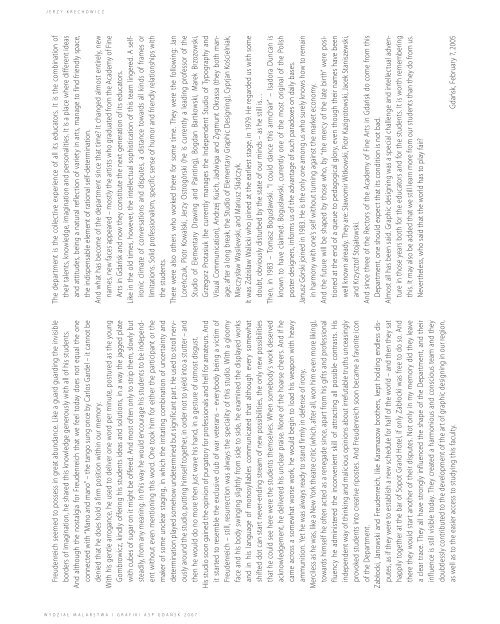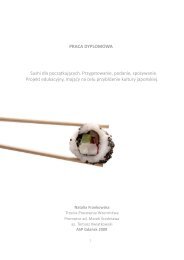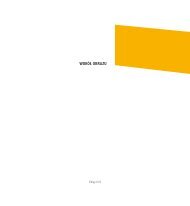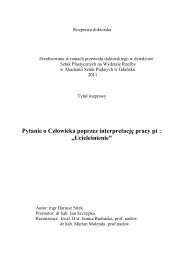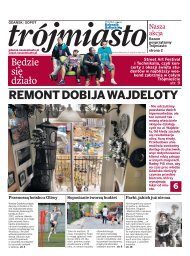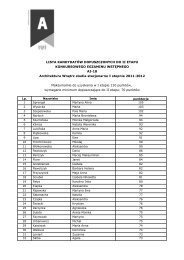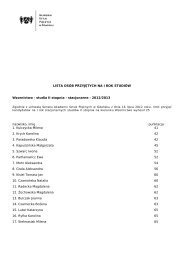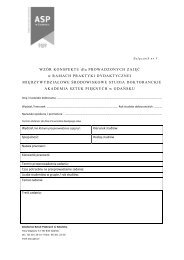P o czet dziek anó w - Akademia Sztuk Pięknych w Gdańsku
P o czet dziek anó w - Akademia Sztuk Pięknych w Gdańsku
P o czet dziek anó w - Akademia Sztuk Pięknych w Gdańsku
Create successful ePaper yourself
Turn your PDF publications into a flip-book with our unique Google optimized e-Paper software.
J E R Z Y K R E C H O W I C Z<br />
The department is the collective experience of all its educators. It is the combination of<br />
their talents, knowledge, imagination and personalities. It is a place where different ideas<br />
and attitudes, being a natural reflection of variety in arts, manage to find friendly space,<br />
the indispensable element of rational self-determination.<br />
And what has become of the department since that time? It changed almost entirely, new<br />
names, new faces appeared – mostly the artists who graduated from the Academy of Fine<br />
Arts in Gdańsk and now they constitute the next generation of its educators.<br />
Like in the old times, however, the intellectual sophistication of this team lingered. A selfironic<br />
climate of conversations and disputes, a distance towards all kinds of frames or<br />
limitations. Solid professionalism, specific sense of humor and friendly relationships with<br />
the students.<br />
There were also others who worked there for some time. They were the following: Jan<br />
Loreńczuk, Piotr Kowalski, Jerzy Ostrogórski (he is currently a leading professor of the<br />
Studio of Elementary Drawing and Painting), Bogdan Bartkowski, Marek Brzozowski,<br />
Grzegorz Protasiuk (he currently manages the Independent Studio of Typography and<br />
Visual Communication), Andrzej Kuich, Jadwiga and Zygmunt Okrassa (they both manage,<br />
after a long break, the Studio of Elementary Graphic Designing), Cyprjan Kościelniak,<br />
Mieczysław Wasilewski, and Mariusz Sładczyk.<br />
It was Zdzisław Walicki who joined at the earliest stage, in 1979. He regarded us with some<br />
doubt, obviously disturbed by the state of our minds – as he still is…<br />
Then, in 1983 – Tomasz Bogusławski. “I could dance this armchair” – Isadora Duncan is<br />
known to have claimed. Bogusławski, currently one of the most original of the Polish<br />
poster designers, informs us of the advantage of such paradoxes on daily bases.<br />
Janusz Górski joined in 1983. He is the only one among us who surely knows how to remain<br />
in harmony with one’s self without turning against the market economy.<br />
And the future will be shaped by those who, by “the mercy of the late birth” were positioned<br />
at the end of a queue to pedagogical glory, even though their names have been<br />
well known already. They are: Sławomir Witkowski, Piotr Kazigrotowski, Jacek Staniszewski,<br />
and Krzysztof Stojałowski.<br />
And since three of the Rectors of the Academy of Fine Arts in Gdańsk do come from this<br />
Department, one should expect that its condition is not bad.<br />
Almost all has been said. Graphic designing was a special challenge and intellectual adventure<br />
in those years both for the educators and for the students. It is worth remembering<br />
this. It may also be added that we still learn more from our students than they do from us.<br />
Nevertheless, who said that the world has to play fair?<br />
Freudenreich seemed to possess in great abundance. Like a guard guarding the invisible<br />
borders of imagination, he shared this knowledge generously with all of his students.<br />
And although the nostalgia for Freudenreich that we feel today does not equal the one<br />
connected with “Mano and mano” – the tango sung once by Carlos Gardel – it cannot be<br />
denied that he does hold a firm position within our memory.<br />
With his gentle arrogance, he used to deliver one word per minute, postured as the young<br />
Gombrowicz, kindly offering his students ideas and solutions, in a way the jagged plate<br />
with cubes of sugar on it might be offered. And most often only to strip them, slowly but<br />
steadily, from any meaning. In this way he would encourage his students to be independent<br />
without even mentioning this word. One took him for either the participant or the<br />
maker of some unclear staging, in which the irritating combination of uncertainty and<br />
determination played somehow undetermined but significant part. He used to stroll nervously<br />
around the studio, putting himself together, in order not to yield into a stutter – and<br />
then he would do no more then just wave his hand, in a gesture of utmost disgust.<br />
His studio soon gained the opinion of purgatory for professionals and hell for amateurs. And<br />
it started to resemble the exclusive club of war veterans – everybody being a victim of<br />
Freudenreich – still, resurrection was always the speciality of this studio. With a gloomy<br />
face and his body swinging slightly from side to side, he examined the displayed works<br />
and in his language of monosyllables communicated that although every somewhat<br />
shifted dot can start never-ending stream of new possibilities, the only new possibilities<br />
that he could see here were the students themselves. When somebody’s work deserved<br />
acknowledgement, he delivered his unclear praise. None of the hoarse cheers. And if he<br />
came across a somewhat worse work, he would begin to load his weapon with heavy<br />
ammunition. Yet he was always ready to stand firmly in defense of irony.<br />
Merciless as he was, like a New York theatre critic (which, after all, won him even more liking),<br />
towards himself he often acted as a renegade since, apart from his gifts and professional<br />
fluency he administered the inconvenient skill of attracting all possible contrasts. His<br />
independent way of thinking and malicious opinions about irrefutable truths unceasingly<br />
provoked students into creative ripostes. And Freudenreich soon became a favorite icon<br />
of the Department.<br />
Zabłocki, Janowski and Freudenreich, like Karamazow brothers, kept holding endless disputes,<br />
as if they were to establish a new schedule for half of the world – and then they sat<br />
happily together at the bar of Sopot Grand Hotel, if only Zabłocki was free to do so. And<br />
there they would start another of their disputes. Not only in my memory did they leave<br />
a clear trace. They all have strongly influenced the shape of the Department, and their<br />
influence is still visible today. They created a harmonious and conscious team and they<br />
doubtlessly contributed to the development of the art of graphic designing in our region,<br />
as well as to the easier access to studying this faculty.<br />
W Y D Z I A Ł M A L A R S T W A I G R A F I K I A S P G D A Ń S K 2 0 0 7<br />
Gdańsk, February 7, 2005


